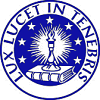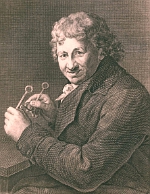
 | The German Huguenot Museum in Bad Karlshafen |
 |
Nicholas Daniel ChodowieckiBiography - Part 1 Nicholas Daniel Chodowiecki Nicholas Daniel Chodowiecki was born in Danzig on 16th October 1726 as son of the Polish corn merchant Gottfried Chodowiecki (1698-1740) and Marie Henriette Ayrer. Nicholas Daniel Chodowiecki was born in Danzig on 16th October 1726 as son of the Polish corn merchant Gottfried Chodowiecki (1698-1740) and Marie Henriette Ayrer. His father taught him miniature painting. His mother, a descendant of the Huguenot family de Vaillet, brought him up in the French-Reformed tradition. Daniel Chodowiecki remained true to this tradition throughout his life. We know from his diary that he attended both church services on Sundays and made notes on the sermon - as subject matter for later discussions in the family circle. The artist considered his work to be service to God. Duty was on of the maxims according to which he led his life (Badstübner-Gröger). At the age of 17 he went to Berlin to stay with his uncle. He mixed with the Huguenots in the French colony and on 18th July 1755 he married the Huguenot Jeanne Barez. He was an active member of the French church, holding the offices of elder and deacon. Artistic worksChodowiecki applied himself first to the painting of enamels. He did not succeed in becoming a painter. It was his talent for portraying scenes of everday life in Berlin that made him famous. These etchings were kept quite small. Ir was his copper engraving depicting the judicial murder of a Huguenots "Calas's farewell to his family" in 1767 which brought him fame as an engraver. He was much in demand as an illustrator. His engravings adorned many classical works. His illustrations of the elementary work of Johann Bernhard Basedow (1723-1790), a leading educationalist of that era, deserve special mention. Noteworthy are also his portraits for the "Physiognomische Fragmente" of Johann Casper Lavater (1741-1811), the Zürich minister who was a friend of Goethe. His engravings illustrated the almanachs of his time, especially the Göttingen pocket calendar of the philosopher Georg Christoph Lichtenberg (1742-1799). Art for the HuguenotsChodowiecki often chose Huguenot themes for his etchings. He did two series on the Massacre of St Bartholomew's Day. Other events in Huguenot history were also the subject of his engravings. The Berlin soap dealer Henry Gierart was depicted in a humorous manner, as was also the Huguenot Nicolas Fonvielle (the dice-player). The artist's happy dispostion is demonstrated in his etching "The pilgrimage to Französisch-Bucholz" depicting a family picnic to this Huguenot village. The engraving of the artist's family in his study "Cabinet d'un peintre" is much sought after by collectors as are the engravings of the charming young ladies in the French colony. The frontispiece of all nine volumes of hte history of the Huguenots in Prussia by Erman and Reclam "Mémoires pour servir à l'histoire des Réfugiés François dans les États du Roi" (1782-1799) is an engraving by Chodowiecki. The painting on a fan which depicts the French Cathedral in Berlin is attributed to Chodowiecki. The fan which probably dates from 1785 is on display in the museum. There is an inscription above the tower: "Tolerance is rebuilding the churches Burning houses in the background call to mind the fate of the Huguenots in France, and a French inscription draws attention to the consolation the Huguenots in Berlin received from the Great Elector. Chodowiecki also played his part in the décor of the exterior of the French Cathedral in Berlin. The biblical scenes on the gables represent the culmination of his artistic talent as here two of his driving forces come together - his Reformed faith and social commitment and his artistic engagement for the colony (Badstübner-Gröger). For the French colony in Berlin Chodowiecki also designed the commemorative medal to mark the centenary of the Edict of Potsdam of 29th October, 1785, and exlibris for the French seminar library, and above all, the frontispiece of a French psalm book first printed in Berlin in 1759 depicting David playing the harp. The frontispiece of later editions of the psalm book in 1783 and 1791 depict variations of the theme David with the harp. Biography - Part IIIn 1764, in recognition of his achievements, Chodowiecki became a member of the Berlin Academy of Arts. 1797 he became its director. On 7th February 1801 the artist died, highly respected and much mourned. He was brought to rest in the French graveyard in the Chausée-Strasse in Berlin. The present gravestone was placed there at a later date. His over 2,000 copper engravings, his drawings, miniatures and paintings are today in many museums and private collections. They keep alive the memory of the most loyal, kind and modest portrayer of his world that ever an age has seen (Paul Kristeller). The AuthorSibylle Badstübner-Gröger, Daniel Chodowieckis Arbeiten für die französische Kolonie in Berlin. In: Hugenotten in Berlin. Berlin 1988. Ursula Fuhrich-Grubert und Jochen Desel (Hg.), Daniel Chodowiecki (1726-1801). Bad Karlshafen 2001. Begleitbuch mit Katalog zur Ausstellung. Robert Violet, Daniel Chodowiecki (1726-1801). Eine verschollen geglaubte Autobiographie. Bad Karlshafen 2010. |
© The German Huguenot Museum 2026 |